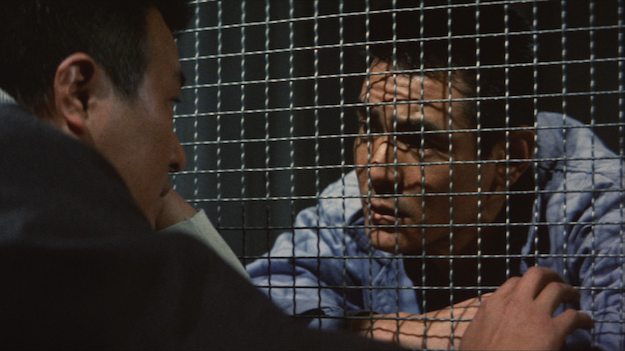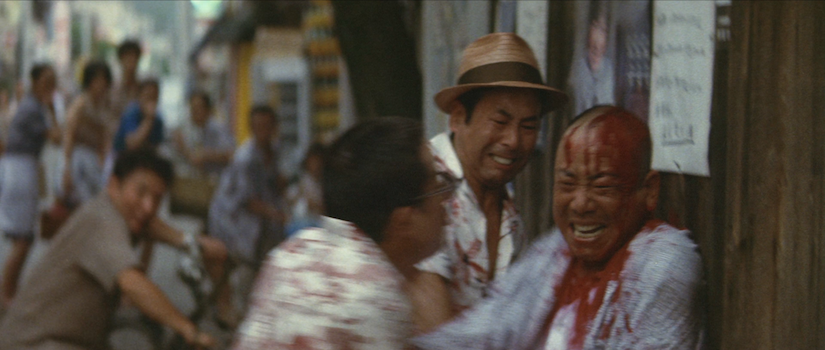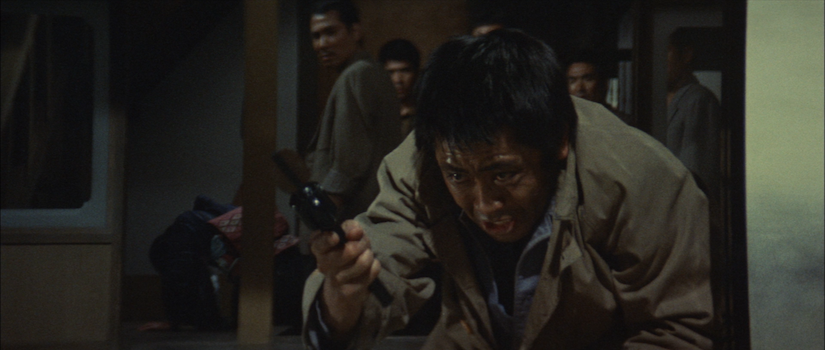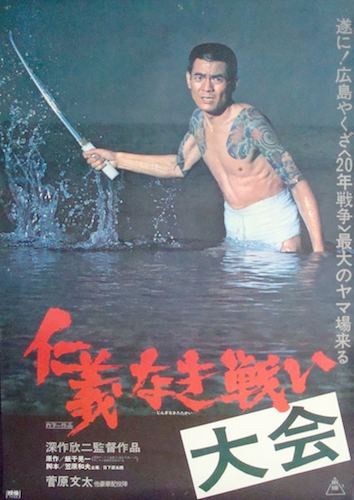| Reviews & Columns |
|
Reviews DVD TV on DVD Blu-ray 4K UHD International DVDs In Theaters Reviews by Studio Video Games Features Collector Series DVDs Easter Egg Database Interviews DVD Talk Radio Feature Articles Columns Anime Talk DVD Savant Horror DVDs The M.O.D. Squad Art House HD Talk Silent DVD
|
DVD Talk Forum |
|
|
| Resources |
|
DVD Price Search Customer Service #'s RCE Info Links |
|
Columns
|
|
|
Battles Without Honor and Humanity: The Complete Collection
The Collection:

The Japanese gangster film series Battles Without Honor and Humanity (aka The Yakuza Papers) is often compared to The Godfather films. They both were initially released around the same time (in the case of the Battles films, once every few months during 1973 and 1974), and they both became wildly influential. The parallels end there, however, because The Godfather invested its vision of post-WWII Mafia life with unexpected warmth, contemplative depth, and tragic gravitas, while the Battles films are breathless, ruthless, and unsentimental to the nth degree. The Battles films have no time for the Shakespearean family tragedy of the Coppola films, since they are too busy upending previous cinematic visions of the yakuza as men ruled by a code of honor. As the title suggests, the characters in the Battles films are not men of honor; they are all petty schemers, hungry for power and surrounded by chaos.
Director Kinji Fukasaku (Battle Royale) and his screenwriters adapt the real-life exploits of the street gangs of Hiroshima and Kure during the quarter century that followed the end of World War II. (The series begins with a photograph of the atomic bomb exploding over Hiroshima, intimating that while this bomb might have concluded one war, the fight on the streets of Hiroshima was just starting.) The first film, 1973's Battles Without Honor and Humanity, sets the tone for all five films in a matter of seconds. In the middle of the black market, an American GI grabs a young Japanese girl and pulls her into a shed to start raping her. Some Japanese ex-army men, including our main character, Shozo Hirono (Bunta Sugawara), pull the American off the girl, beat him up, and are on the run from the military police in what seems like the blink of an eye. Meanwhile, some gang members corner two punks horning in on their action and chop an arm off of each of them, creating giant gushes of blood.
In other words, don't expect tasteful action, punctuated by cathartic blood-letting. The violence in the Battles films is wild, flailing, disorienting, unsafe, and unsatisfying. Acts of violence are not carried out by fashionably dressed assassins who kill with superhuman skill and disarming panache; instead, they are performed by dumbass foot soldiers who can't aim or whose guns jam or who are irredeemably psychopathic. It would almost be intolerable if not for Fukasaku's clear dark sense of humor about the entire situation.
For example, the main illustration of the new Battles box set is of a severed pinky, which is ominous, but it refers to a fairly humorous sequence in the first film. Humbled after insulting a powerful man, Shozo decides to chop off a pinky as penance -- but first, he has to find out how exactly one does that. After he has been given advice by the boss's wife on the proper way to slice, he does so -- only to have the pinky bounce away and disappear. Eventually, it is found in a nearby chicken coop, already pecked at by the chickens.

The overall narrative of the five films is unruly, as the cast of characters seems to expand not only from film to film, but from moment to moment, making it a chore to keep track of who belongs to what family, and which families become aligned with which others, and therefore which families are put into opposition, and which friendships are put in jeopardy by these oppositions, etc. The box set comes with a hard-bound book, and it includes character family trees, laying out the notable relationships of each film, but these illustrations amount to a convoluted tangle of connections that make them almost a piece of visual comedy rather than helpful guides.
In other words, forgive me if the following synopsis reads as extremely reductive, but it seems necessary -- if only to keep this review from expanding to a book-length screed. Battles Without Honor and Humanity essentially concerns the transformation of Shozo Hirono from a disgruntled ex-soldier into a disgruntled underboss of the yakuza. After gunning a man down in the street, Shozo is sent to prison, where he becomes blood brothers with a mob guy. Ever grateful, the family gets him sprung from prison and makes him one of their own. He joins a family led by a weasel named Yamamori (Nobuo Kaneko), whose apparent cowardice and incompetence would seem to make him a bad boss, but as the movies wear on, it becomes clear that he's actually fairly average. Eventually, the ever-present, ever-spinning webs of deceit and piled-up double-crosses lead to a series of showdowns where underbosses drop like flies. At the end of the first movie, Shozo decides to break with Yamamori and head out on his own.
In the second film, Hiroshima Death Match (also 1973), Shozo has started his own tiny yakuza family. Oddly, however, Shozo is basically a side character, while two other men come into focus. One is another of Shozo's prison acquaintances, Yamanaka (Kinya Kitaoji), who was too young to fight in World War II but seems to carry on a self-destructive kamikaze spirit nonetheless. The other is Otomo (the Street Fighter himself, Shinichi "Sonny" Chiba), a swaggery tough guy asshole who decides that the black market is too small-potatoes for him, so he tries to grab a slice of the gambling pie. Both of these men end up orbiting around Hiroshima boss Muraoka (Hiroshi Nawa), with Yamanaka joining the boss's ranks and falling madly in love with his niece (Meiko Kaji, of Stray Cat Rock and Lady Snowblood) and Otomo declaring guerrilla war against the boss. Hiroshima Death Match is one of my favorite entries in the series, partly because of the stand-alone nature of its story, partly because of the excellent featured cast (many of whom don't come back for later entries -- at least not as these characters), and partly because of the smaller scope and mellower pace compared to the films around it. Also, the less frantic nature of the film overall makes the violent scenes in this entry more intense, powerful, and indelible.
The next two films, Proxy War (1973) and Police Tactics (1974), put the focus back on Shozo Hirono and the Yamamori family, as Yamamori finagles his way into becoming the big boss of Hiroshima. A series of new alliances and skirmishes between foot soldiers puts Shozo and Yamamori basically back on the same team, which means Shozo has to conceive of ways to bring down his old boss without getting his hands dirty. He tries to throw his hat in with a top guy named Uchimoto (Takeshi Kato), but he turns out to be an even more spineless snake than Yamamori. (When it comes to grotesquely comic figures who are nonetheless sadly plausible, Uchimoto has to be one of cinema's all-time greats.) During this era, the families grow and merge, come under more intense police scrutiny, and inevitably decline.
The last film in the series, Final Episode (1974), was not originally planned, but it is thankfully much more than a needless cash-in sequel. Instead, it provides an effective epilogue to the previous entries, in a melancholy Godfather III-like mode. The big yakuza family in Hiroshima tries to go respectable, under the leadership of the even-tempered Takeda (Akira Kobayashi) and his assistant Matsumura (Kinya Kitaoji, playing a new role). They face opposition both from outside yakuza forces, such as Shozo's small family, and from elements within, such as hot-headed board member Otomo (now played by Branded to Kill's chipmunk-cheeked Jo Shishido) -- with neither side ready to let the family forget its bloody roots.
Taken as a whole (which is oddly easy to do, considering the flood of characters and convoluted relationships), the Battles series is immensely entertaining. Unlike many modern serialized film stories, each entry has a story to tell and a reason to exist beyond just extending a franchise. As such, there's a welcome consistency to these pulpy tales of street gangsters and the clueless overgrown children who command them. Viewers with an aversion to bloody violence, or those looking for many strong female characters in the midst of this macho sausage fest, should probably steer clear. But otherwise, it's a head-spinning blast.

The Blu-ray
Battles Against Honor and Humanity: The Complete Collection is a limited edition release, with only 2500 copies available in Region A. The box set contains the five main features, complete with supplements, on one Blu-ray and one DVD apiece, as well as the Complete Saga re-edit of the first four features (see below) on one Blu-ray and two DVDs. The box also contains a hard-bound 146-page book, including color stills, credits, a character family tree, and several essays about this film series and the yakuza subgenre.
The Video:
Considering the grainy, almost-documentary look of this series, this collection of AVC-encoded 1080p 2.35:1 transfers is very strong. Fine detail comes and goes, and certain sequences look like they must have been shot on reversal film stock because of the way the colors suddenly go haywire and the grain gets chunky, but it all fits in with the style that director Kinji Fukasaku and cinematographer Sadaji Yoshida have established. Very little in the way of dirt and specks, and the encode's generous bitrate ensures there are no noticeable digital compression issues.
The Audio:
Apart from some random pops and the era-specific limitations of the recordings, the Japanese LPCM mono audio tracks (with optional English subtitles) on all five films are completely satisfying, with nicely layered ambience in some of the (rare) quiet moments and no painful overmodulation when all hell breaks loose (which is most of the time).
Special Features:
(HD, 3:00) - The film's assistant director, Toru Dobashi, explains how he was asked by the studio and Fukasaku to take charge of creating this omnibus, and why he decided to only use footage from the first four films.
Final Thoughts:
Kinji Fukasaku is a genre master with an anarchic sensibility, making these films a unique treat for gangster-flick fans. This reissue of his signature series is yet another outstanding, must-own release from Arrow. The A/V upgrade over the already quite good 2004 DVD release of these films would probably be enough to inspire a purchase, but the gorgeous hard-bound book and copious brand-new supplemental features make it irresistible. DVD Talk Collector Series.

Justin Remer is a frequent wearer of beards. His new album of experimental ambient music, Joyce, is available on Bandcamp, Spotify, Apple, and wherever else fine music is enjoyed. He directed a folk-rock documentary called Making Lovers & Dollars, which is now streaming. He also can found be found online reading short stories and rambling about pop music.
|
| Popular Reviews |
| Sponsored Links |
|
|
| Sponsored Links |
|
|
| Release List | Reviews | Shop | Newsletter | Forum | DVD Giveaways | Blu-Ray | Advertise |
|
Copyright 2024 DVDTalk.com All Rights Reserved. Legal Info, Privacy Policy, Terms of Use,
Manage Preferences,
Your Privacy Choices | |||||||













